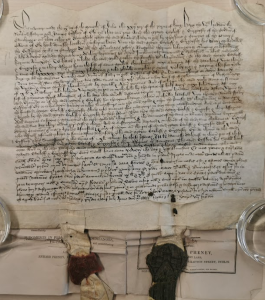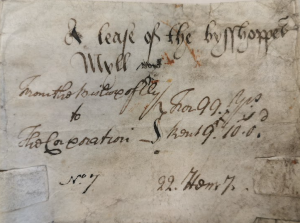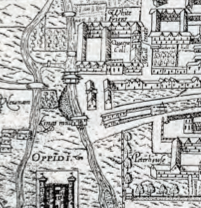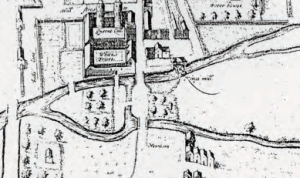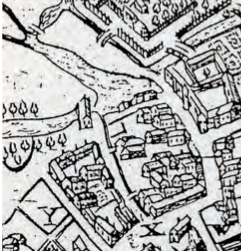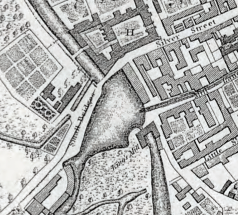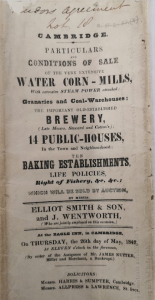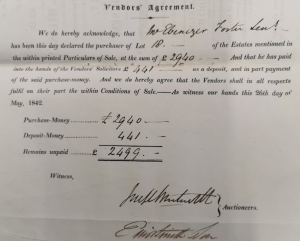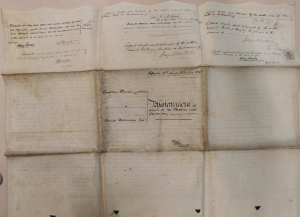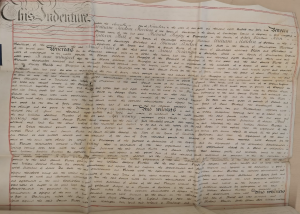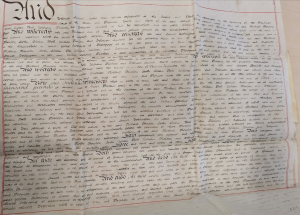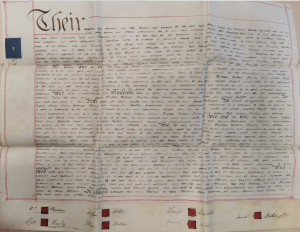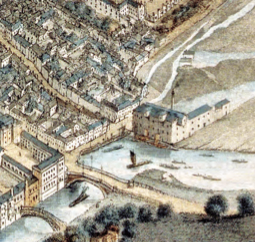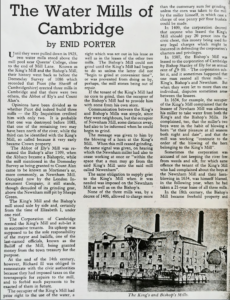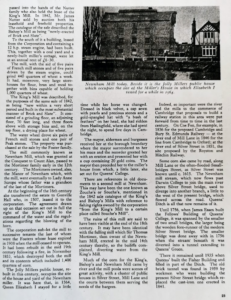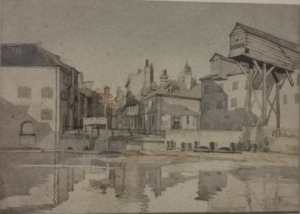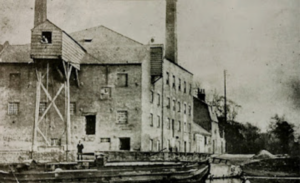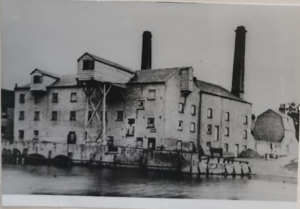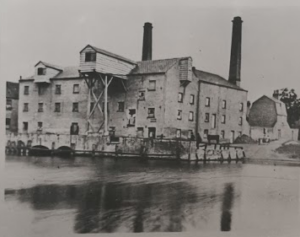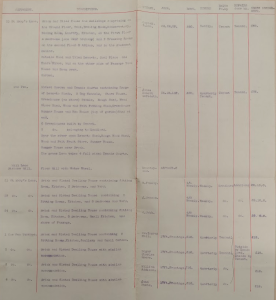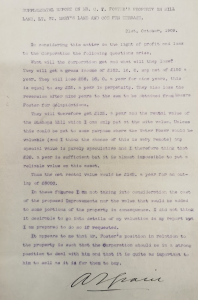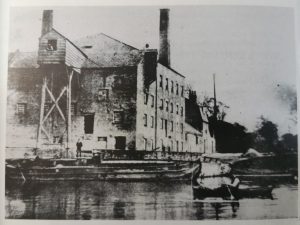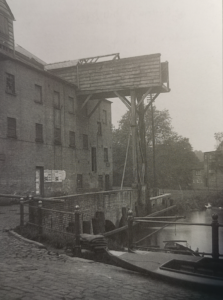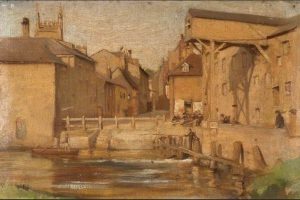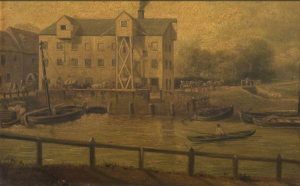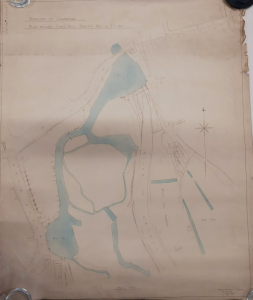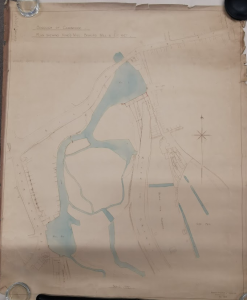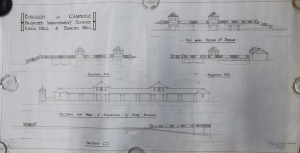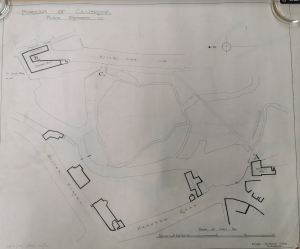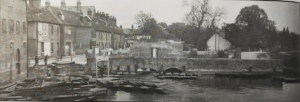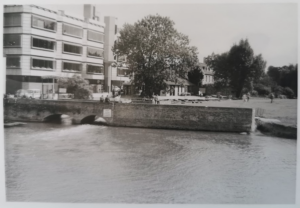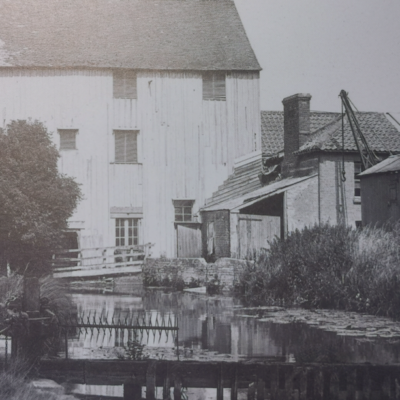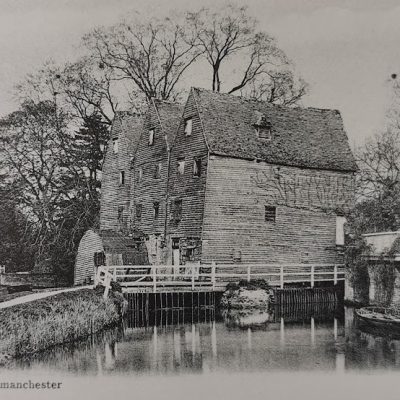Search by topic
- archaeology
- Building of Local Interest
- chapel
- charity
- church
- crime
- dressmaker
- Great Eastern Railway
- Listed building
- Mapping Relief
- medieval
- oral history
- poverty
- Public House
- Rattee & Kett
- Religious House
- Roman
- scholar
- school
- Then and Now
- tudor
- women
- work
- world war one
- world war two
Search by text
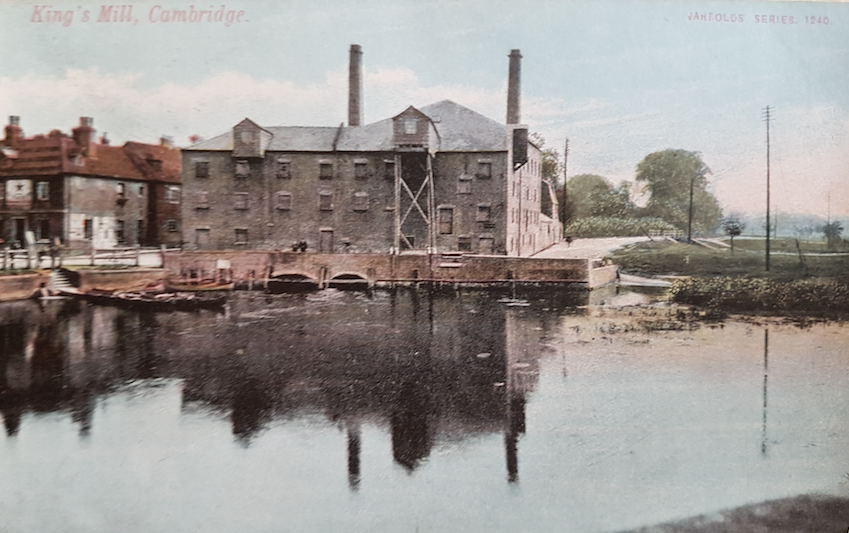 King's Mill, Granta Place (MoC)
King's Mill, Granta Place (MoC)King’s Mill and Bishop’s Mill, Granta Place
History of King's Mill site
To read about James Nutter, miller of Cambridge, as told in his diary of 1804, follow this link:
7 months in the life of James Nutter Miller of Cambridge
The Domesday Book, 1086, attests the presence of two mills on the River Granta (Cam), one belonging to the Abbot of Ely and the other to a certain Count Alan. The two mills in question are probably the Bishop’s Mill and the Newnham Mill. The King’s Mill was probably erected slightly later and right next to the Bishop’s Mill.
1507 On the 9th July James Stanley, Bishop of Ely, agrees to lease the Bishop’s Mill to the Corporation of Cambridge with all commodities, profits and meadows attached. The lease is for 99 years from Christmas Day. The rent is £9 10s and the Corporation of Cambridge has to agree to pay for the repair of the mill and dam.
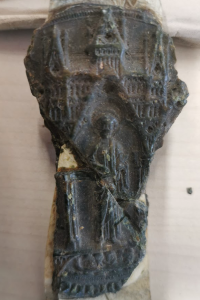
Seal of Lease 1507 of the Bishop’s Mill, Cambridge (courtesy of Cambridgeshire Archives, KCB/1/C/10/55)
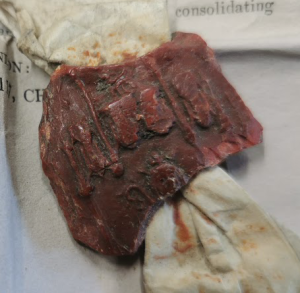
Seal of Lease 1507 of the Bishop’s Mill, Cambridge (courtesy of Cambridgeshire Archives, KCB/1/C/10/55)
The Corporation of Cambridge then sublets the mill to a number of people including Hugh Chapman, Thomas Simpson (1566 lease) who also owns the lease for the King’s Mill, and Oliver Flynt (1572 lease).
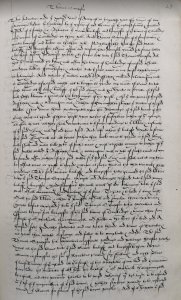
Lease 1567 of King’s Mill to Thomas Simpson (courtesy of Cambridgeshire Archives, KCB/2/CL/17/1 page 23 & 24)
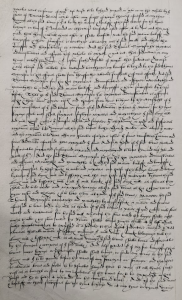
Lease 1567 of King’s Mill to Thomas Simpson (courtesy of Cambridgeshire Archives, KCB/2/CL/17/1 page 23 & 24)
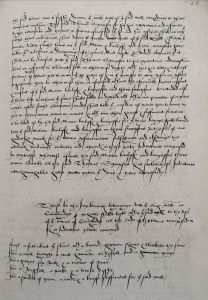
Lease 1567 of King’s Mill to Thomas Simpson (courtesy of Cambridgeshire Archives, KCB/2/CL/17/1 page 23 & 24)
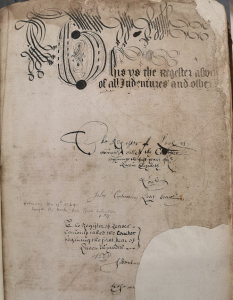
Front page of Corporation of Cambridge Lease book, 16th century (Courtesy of Cambridgeshire Archives, KCB/2/CL/17/1)
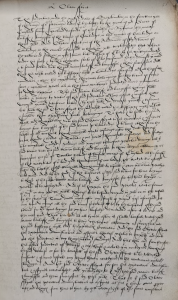
1572 lease of the Bishop’s Mill to Oliver Flint from Corporation of Cambridge (Cambridgeshire Archives KCB/2/CL/17/1/35r)
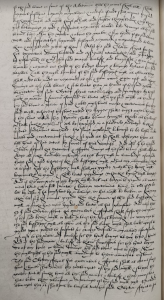
1572 lease of the Bishop’s Mill to Oliver Flint from Corporation of Cambridge (Cambridgeshire Archives KCB/2/CL/17/1/35r)
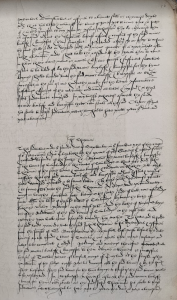
1572 lease of the Bishop’s Mill to Oliver Flint from Corporation of Cambridge (Cambridgeshire Archives KCB/2/CL/17/1/35r)
For more information see Proceedings of the Cambridge Antiquarian Society Vol 14, 1910. Dr Stokes, The Old Mills of Cambridge, pp180-233.
The King’s Mill can be seen on Richard Lyne’s 1574 map, straddling the eastern tributary of the river.
In the 1575 map by George Braun, the mill can be seen from a different perspective.
The mill is visible in the Speed 1610 map.
It is labelled King’s Mill in Custance’s 1789 map.
From the late eighteenth century until 1842, the King’s and Bishop’s mills were managed by the Nutter family. First by James Nutter (father) and then by his son who bore the same first name. The first James Nutter was a fervent Baptist who was very involved in the life of Saint Andrew’s Church and became a close friend of the famous Baptist preacher Robert Hall. The story of their friendship is known thanks to James Nutter’s diary that has survived and has been the subject of a blog published by the Museum of Cambridge and that can be found in a pdf form here:
7 months in the life of James Nutter Miller of Cambridge
After his father retired, James Nutter (son) took over the business which he expanded by buying a brewery and associated pubs before being declared bankrupted in 1842. All the premises associated with the business were then sold at auction. The sale brochures preserved in the Cambridgeshire Archives are shown below. This was a spectacular bankruptcy that sent shockwaves across the town and led James Nutter (son) to leave and move to Warwickshire.
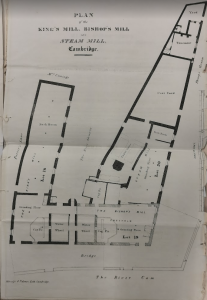
Plan of King’s and Bishop’s Mill produced for 1842 sale brochure of James’ Nutter’s properties (Cambridgeshire Archives)
1842_Sale_of_Nutter_properties
The brochure contains a detailed description of the two mills.
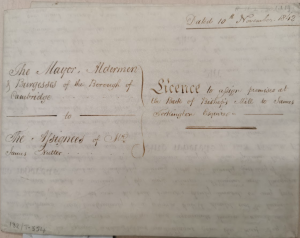
10th November 1842, lease to assign premises at back of Bishop’s Mill to James Torkington (Cambridgeshire Archives K132/T354)
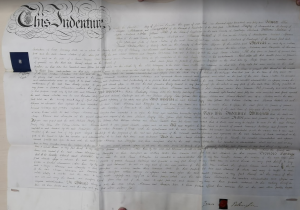
10th November 1842, lease to assign premises at back of Bishop’s Mill to James Torkington (Cambridgeshire Archives K132/T354)
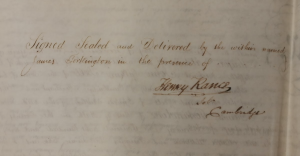
10th November 1842, lease to assign premises at back of Bishop’s Mill to James Torkington (Cambridgeshire Archives K132/T354)
The editor of Romilly’s Cambridge Diary (May 1846) notes that there were two medieval watermills on the Cam at the end of Mill Lane. The King’s miller had had first claim in time of drought and if at other times he had no corn to grind the Bishop’s miller could use the supply on payment of a portion.
H.P.Stokes relates the story of the Cambridge mills in The Old Mills of Cambridge, PCAS vol.14. Two shared the same roof. One, the Bishop’s Mill, had belonged to the Abbot of Ely at the time of the Domesday survey. The other, the King’s Mill, had been erected soon afterwards. Both were acquired by Ebenezer Foster in 1842 but when the railway arrived he built new mills in Station Road.
The following description of the old mill comes from Period Piece (pub 1952) by Gwen Raverat who lived nearby:
In those days both the mills were in use. I still now feel that there is an unnatural gap in the landscape where Foster’s Mill used to stand before it was pulled down; and I find it hard to believe that the boys, who sit fishing on the parapet, have no idea that there once was a
great mill behind them. We used to spend many hours watching the fat corn-sacks being hauled up by a pulley into the overhanging gable, sometimes from a barge, but more often from the great yellow four-horse wagons, which stood beneath the trapdoor. The sacks butted the trapdoors open with their own noses, and the doors fell to, with a loud clap, behind them.
1871 Foster’s Yard
William Prime, 44, labourer, b Barton
1879
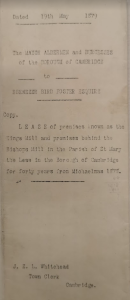
1879 Transfer of Lease of King’s Mill by Corporation of Cambridge to Ebenezer Bird Foster (courtesy Cambs Archives K132/T/354)
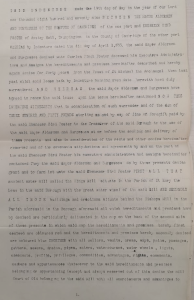
1879 Transfer of Lease of King’s Mill by Corporation of Cambridge to Ebenezer Bird Foster (courtesy Cambs Archives K132/T/354)
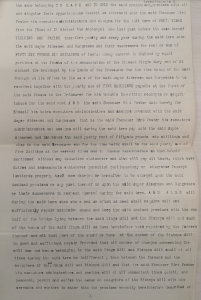
1879 Transfer of Lease of King’s Mill by Corporation of Cambridge to Ebenezer Bird Foster (courtesy Cambs Archives K132/T/354)
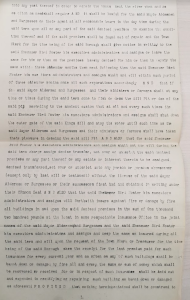
1879 Transfer of Lease of King’s Mill by Corporation of Cambridge to Ebenezer Bird Foster (courtesy Cambs Archives K132/T/354)
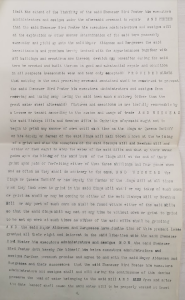
1879 Transfer of Lease of King’s Mill by Corporation of Cambridge to Ebenezer Bird Foster (courtesy Cambs Archives K132/T/354)
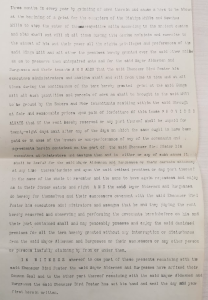
1879 Transfer of Lease of King’s Mill by Corporation of Cambridge to Ebenezer Bird Foster (courtesy Cambs Archives K132/T/354)
1909
By 1909 a report commissioned by the Corporation of Cambridge shows that the mills which were part of the Fosters’ estates are seriously delapidated and have lost much of their value. The Town will eventually purchase the estate and demolish the mills.
Fosters_1909 (Cambridgeshire Archives)
1910
Foster estate Valuation 1910 (Cambridgeshire Archives)
For Mary Greene’s reminiscences of the mills see her autobiography, The Joy of Remembering.
1924
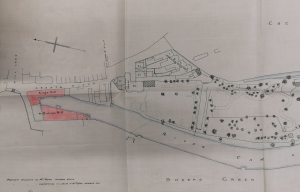
Plan of King’s and Bishops’s Mill area 1924 (Courtesy of Cambridgeshire Archives KCB/2/SE/1/1/127/3)
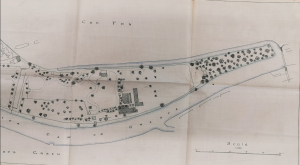
Plan of King’s and Bishops’s Mill area 1924 (Courtesy of Cambridgeshire Archives KCB/2/SE/1/1/127/3)
1926
1928
The site was originally going to be cleared to make a new bridge. This scheme collapsed and the Council decided just to clear the area and reconstruct the sluices and slipway. The cottages in the background were replaced by the University Centre in 1967.
Contribute
Do you have any information about the people or places in this article? If so, then please let us know using the Contact page or by emailing capturingcambridge@
License
This work is licensed under CC BY-NC-SA 4.0





